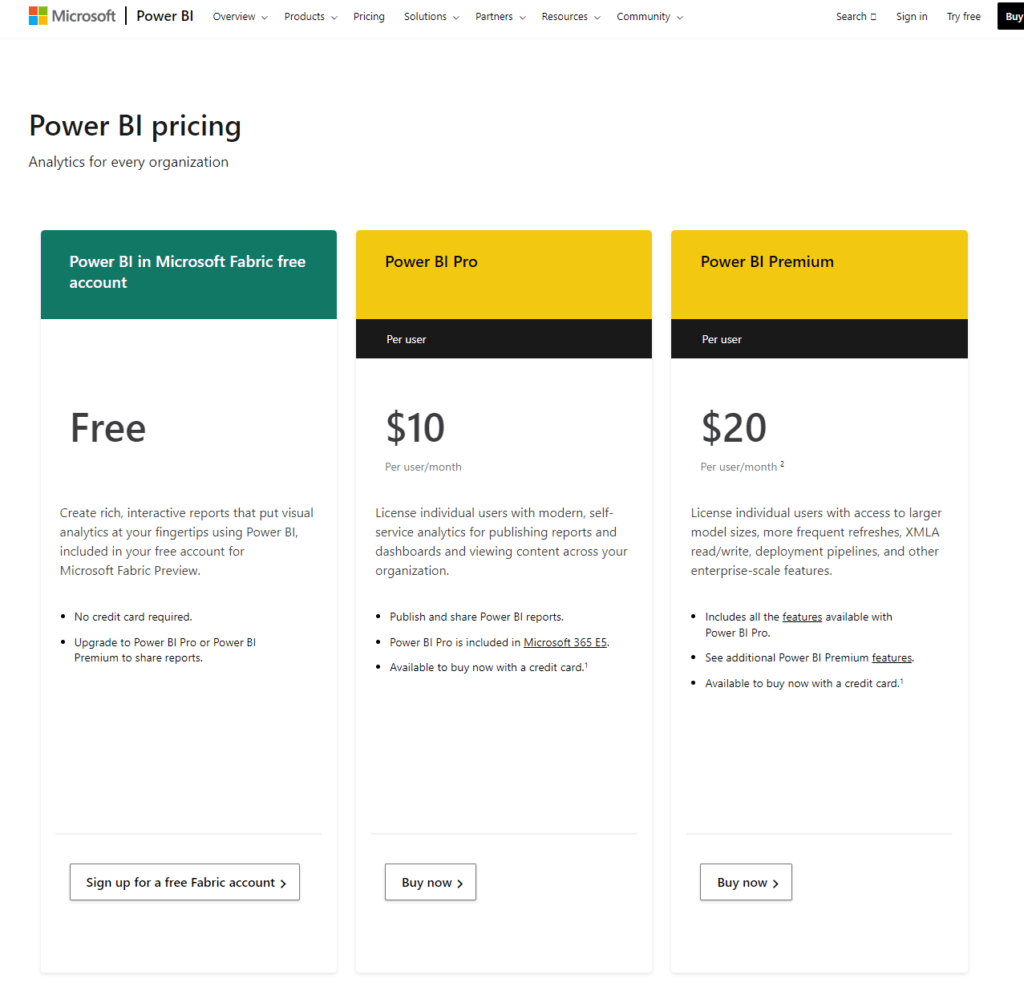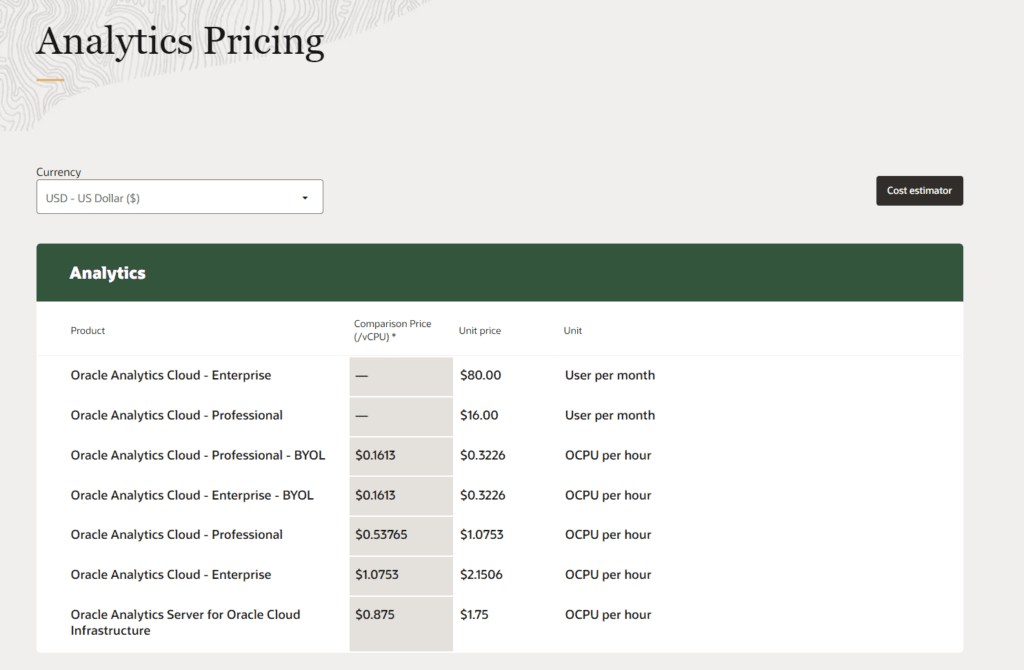In today’s fast-paced digital landscape, harnessing the power of data analytics is not just an advantage; it’s a necessity. Amidst the sea of analytics tools, Microsoft Power BI and Oracle Analytics Cloud emerge as towering lighthouses, guiding businesses towards data-driven decision-making. But which beacon should you steer your ship towards? Whether you’re a fledgling startup navigating the initial waves of business intelligence or an established enterprise sailing the vast oceans of big data, choosing the right analytics tool can chart the course to your success. Let’s dive into a crucial area of comparisons.
| Microsoft Power BI | Oracle Analytics Cloud |
|---|---|
 |  |
| G2 Score -4.5 out of 5 | G2 Score -4.0 out of 5 |
| TrustRadius Score -8.3 out of 10 | TrustRadius Score -8.1 out of 10 |
User Experience and Dashboard Usability: The Compass for Navigating Data
In the vast ocean of analytics, the design and functionality of a platform’s dashboard are the sails that catch the wind, propelling your business forward. Both Microsoft Power BI and Oracle Analytics Cloud offer distinct approaches to how they present data and enable users to interact with their insights.
Microsoft Power BI: Charting a Course with Clarity
Microsoft Power BI is renowned for its intuitive design and user-friendly interface, making it accessible for users of all skill levels. The platform emphasizes visual data exploration, allowing users to create and customize dashboards with ease.
Its drag-and-drop functionality simplifies the process of building complex reports, and the ability to quickly switch between different data visualizations helps illuminate insights from various angles. For businesses looking for a tool that balances powerful analytics capabilities with ease of use, Power BI ensures that navigating through data feels more like sailing on a clear day rather than braving a storm.
Oracle Analytics Cloud: Navigating the Depths with Precision
Oracle Analytics Cloud, catering to a more technologically adept audience, offers a robust suite of tools designed for deep data analysis. While it boasts comprehensive customization options and advanced analytics features, the platform’s complexity can present a steeper learning curve for new users.
However, for businesses that require granular control over their data analysis and the ability to perform sophisticated data modeling, Oracle Analytics Cloud provides the navigational instruments needed to chart the most intricate courses. Its dashboard and user interface are engineered to handle the demands of enterprise-level analytics, making it a powerful, if somewhat more challenging, tool to master.
Pricing Strategies: Charting the Cost of Insights
The investment in an analytics platform is a significant consideration for any business, impacting not just immediate budgets but also long-term strategy. Let’s hoist the sails and examine how Microsoft Power BI and Oracle Analytics Cloud structure their pricing to offer value to their users.
Microsoft Power BI: Flexible Pricing for Varied Treasures

Microsoft Power BI’s pricing model is designed with flexibility in mind, aiming to cater to individuals, teams, and enterprises with different needs and budgets. The platform offers a free version, Power BI Desktop, which provides a robust set of data analytics and reporting features, suitable for individual users or small teams just beginning to explore the world of analytics.
For more advanced capabilities, including cloud services, collaboration tools, and greater data refresh rates, Power BI Pro is available for a monthly subscription fee per user. This tier is geared towards professionals and teams needing to collaborate on analytics projects.
At the top of the tier, Power BI Premium provides dedicated cloud resources, more extensive data storage, and advanced analytics features, priced per capacity, which makes it suitable for large enterprises requiring scalability and performance. Power BI’s tiered pricing ensures businesses can start small and scale as their data analytics needs grow, without diving into the deep end too soon.
Oracle Analytics Cloud: Tailored to the Fleet’s Size

Oracle Analytics Cloud offers a comprehensive suite of analytics tools with pricing that reflects its enterprise-level capabilities. Unlike Power BI, Oracle Analytics Cloud doesn’t offer a free tier, focusing instead on delivering a full-featured platform that can handle the complexity and scale of large organizational data landscapes.
Pricing for Oracle Analytics Cloud is based on a combination of the number of users and the amount of data processed, with specific plans tailored to different sizes and types of usage. This can range from smaller teams looking for basic analytics capabilities to large enterprises needing extensive data integration, advanced analytics, and machine learning features. Oracle’s approach ensures that businesses paying for its platform receive a powerful, enterprise-grade analytics solution that can be customized to their specific requirements.
Integration Capabilities: The Anchor of Your Analytics Journey
In the quest for insightful data analytics, the ability of a tool to seamlessly integrate with your existing digital ecosystem is akin to finding a reliable anchor in turbulent seas. Let’s explore how Microsoft Power BI and Oracle Analytics Cloud fare in creating these vital connections.
Microsoft Power BI: A Versatile Connector
Microsoft Power BI is designed to be the Swiss Army knife of data analytics tools, offering robust integration capabilities across a wide range of data sources and platforms. Its strength lies in its versatility, with native support for a plethora of data connectors including cloud-based services, on-premises databases, and even Excel spreadsheets. This flexibility ensures that businesses of all sizes can bring together disparate data streams into a cohesive analytical view, without the need for complex workaround solutions.
For organizations already invested in the Microsoft ecosystem, such as those using Azure, Dynamics 365, or Office 365, Power BI offers seamless integration, making it a harmonious extension of their current tools. This level of integration simplifies the analytics process, allowing businesses to focus on gleaning insights rather than wrestling with data silos.
Oracle Analytics Cloud: Tailored for the Enterprise
Oracle Analytics Cloud stands as a formidable force in the realm of data analytics, especially for enterprises that require deep, complex data integration capabilities. It excels in handling large volumes of data from diverse sources, including both Oracle and non-Oracle databases, applications, and cloud services. The platform’s strength is its ability to integrate with enterprise-grade systems, offering advanced features like machine learning-based analytics and sophisticated data modeling tools.
For businesses that operate within a complex IT infrastructure or require granular control over their analytics processes, Oracle Analytics Cloud provides the tailored integration capabilities needed to navigate these demands. Its focus on enterprise-level solutions means it is well-equipped to handle the intricate requirements of large organizations, making it a powerful ally in unifying and analyzing extensive data landscapes.
Data Security: The Stronghold of Your Digital Assets
In the realm of analytics, robust data security measures are the cannons that defend your ship against marauders. Microsoft Power BI and Oracle Analytics Cloud each approach this with a keen eye on safeguarding data through comprehensive security features.
Microsoft Power BI: Guarding Your Treasures with Microsoft’s Arsenal
Microsoft Power BI benefits from Microsoft’s extensive experience in cybersecurity, integrating seamlessly with Microsoft’s security infrastructure. This integration provides a multi-layered security model that includes data encryption at rest and in transit, advanced threat detection, and strict compliance with international data protection regulations. Power BI ensures that data governance and access controls are finely tuned, allowing administrators to precisely manage who can view and interact with the data.
Furthermore, Power BI’s commitment to compliance with standards such as GDPR, HIPAA, and more, fortifies the trust businesses place in it for data security. For organizations already anchored in the Microsoft ecosystem, Power BI offers a familiar and secure harbor for their analytics needs.
Oracle Analytics Cloud: The Fortified Citadel of Data
Oracle Analytics Cloud, part of Oracle’s comprehensive cloud suite, is built upon a foundation of stringent security practices. Recognizing the treasure trove of data it handles, Oracle implements rigorous data encryption, both at rest and in transit, alongside robust access management and data governance policies.
Oracle’s analytics solution is designed to meet the security needs of enterprise-scale deployments, offering detailed auditing capabilities, integrated identity management, and compliance with a broad array of global and industry-specific regulations. For large organizations that navigate through the stormy seas of sensitive data daily, Oracle Analytics Cloud serves as a fortified citadel, equipped to protect against the most persistent threats.

Related: Check out our free SEO suite

Advanced Analytics and Reporting Features: Uncovering the Treasure Within
In the quest for competitive advantage, the ability to not just collect data but to analyze it for deep insights is crucial. Both Microsoft Power BI and Oracle Analytics Cloud offer powerful capabilities in this regard, but they cater to different types of analytical voyagers.
Microsoft Power BI: Making Advanced Analytics Accessible
Microsoft Power BI democratizes advanced analytics, making powerful features accessible to users at all levels of expertise. With built-in AI capabilities, Power BI can automatically highlight patterns and trends, offering predictive insights without the need for complex modeling. Its natural language query feature allows users to ask questions directly of their data, making analytics more interactive and accessible.
Additionally, Power BI’s integration with Azure Machine Learning opens up further possibilities for businesses to apply advanced analytics models to their data within the same ecosystem. This blend of accessibility and depth ensures that businesses can explore the treasure trove of their data, uncovering insights that drive strategy and innovation.
Oracle Analytics Cloud: Equipping Analysts for Deep Dives
Oracle Analytics Cloud is designed for deep analytical exploration, offering a suite of tools that cater to the seasoned data analyst. With extensive data modeling capabilities, it allows for the creation of complex analytical scenarios, facilitating detailed exploration of data relationships. Oracle Analytics Cloud also offers powerful machine learning features, enabling users to build, train, and deploy predictive models directly within the platform.
This level of sophistication is complemented by comprehensive reporting features that support the creation of highly customized dashboards and reports. For organizations with the expertise to navigate its depths, Oracle Analytics Cloud is a formidable tool, capable of unlocking nuanced insights that can shape strategic direction.
Conclusion
As we bring our comparative journey of Microsoft Power BI and Oracle Analytics Cloud to a close, we’ve navigated through the key aspects that distinguish these two formidable analytics platforms. From their integration capabilities, which determine how well they can assimilate into your existing digital ecosystem, to the user experience they offer, making the complex task of data analysis accessible and insightful. We’ve charted the course through their pricing strategies, unveiling the investment required to harness their power, and explored the paramount importance of data security, ensuring your digital treasures remain safeguarded against the threats lurking in the vast seas of the internet.
READ NEXT:
- Hotjar vs HubSpot Marketing Analytics: The Best Analytics Tool for You
- Microsoft Power BI vs Mouseflow: The Best Analytics Tool for You
- SEO Strategies for Cryptocurrency Investors: Our Take!
- “GoSquared vs Hotjar: The Best Analytics Tool for You”
- “GoSquared vs Adobe Analytics: The Best Analytics Tool for You”
- 11 Marketing Analytics Tools to Elevate Your Data-Driven Strategies
- 29+ Digital Analytics Software to Skyrocket Your Digital ROI






















Comments are closed.